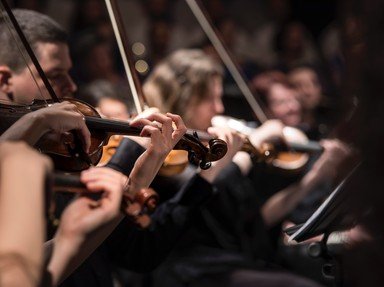Quiz Answer Key and Fun Facts
1. An 18th-century military band would likely have included pairs of oboes, horns, and bassoons. Having received much more recognition for his oratorios, operas, concerti, and sonatas, what German-English composer wrote two arias for the ensemble described above?
2. "On the page it looked like nothing. The beginning simple, almost comic. Just a pulse: bassoons and basset horns, like a rusty squeezebox." The character Salieri speaks these lines in which movie?
3. Outdoor and night music played by wind octets was a delightful source of entertainment for numerous German- and Czech-speaking courts and communities in the late 18th and early 19th centuries. Who was NOT a composer of this type of music?
4. Lacking the power of projection of other woodwinds, the flute was often neglected in earlier works for small wind ensemble. One composer, however, graced us with a set of wind quartets that used a flute in place of the oboe. Who was this man, who also wrote such operatic smash hits as "William Tell," "The Barber of Seville," and "The Thieving Magpie"?
5. The woodwind quintet is now a standard ensemble composed of one each of flute, oboe, clarinet, horn, and bassoon. Numerous composers from the 19th century forward have given us a wide range of works for this versatile, colorful ensemble. Who is considered one of the pioneers of wind quintet music?
6. Chamber music of the Romantic period heavily emphasized strings and the piano, but one prolific man penned an exquisite serenade for nine wind instruments plus bass parts. Who was this Czech master of "New World Symphony" renown?
7. Over the long span of his career, one composer experimented with larger wind ensembles. Not properly called a concert band, as the performance forces do not call for trumpets, trombones, saxophones, or percussion, one may still consider these pieces part of the chamber wind music canon. Sharing the same family name with a certain "Waltz King," what composer wrote these expansive wind symphonies?
8. What French composer wrote "La Cheminée du Roi René," a suite for wind quintet, for a 1939 film?
9. British composer Malcom Arnold's three _____ for woodwind quintet are captivating transformations of the sailing songs "What shall we do with the drunken sailor?," "Boney was a warrior," and "Johnny come down to Hilo." What nautical music word belongs in the blank?
10. All of these gentlemen composed music for woodwind quintet in the 20th century, but who is the odd one out in terms of national origin?
Source: Author
celicadriver
This quiz was reviewed by FunTrivia editor
agony before going online.
Any errors found in FunTrivia content are routinely corrected through our feedback system.

